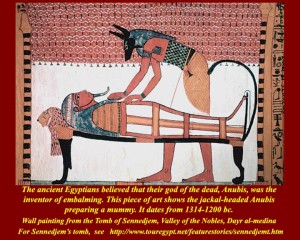While recently talking about ‘Tutankhamun: The Boy King’ during lecture, it got me thinking about the mummification process. Curious to know more, I decided to do a little research on when it began and how exactly it was done.
The process of mummification has two main components: the embalming of the remains, followed by the wrapping and subsequent burial of the body. I have summarized the mummification process below:
- To embalm the body: the body is ‘purified’, or washed, with water from the Nile; the internal organs are removed (minus the heart) and stored in canopic jars; the body is stuffed with natron to allow it to dry out and then covered for forty days; the body is unwrapped, washed again, and coated in oils/embalming agents; the internal organs (still wrapped) are inserted back into the body, along with dry materials to add shape to the corpse, making it look alive again.
- To wrap the mummy: the head and neck are wrapped first, then each individual finger and toe, then each arm and leg. During the wrapping, a priest reads spells to protect the mummy against evil spirits as it moves into the afterlife. Finally, all limbs are tied together and the body is wrapped as a whole. Liquid resins are used to glue the bandages together. Finally, the body is wrapped in two layers of cloth. and put into a coffin, then a second coffin, which is then inset into a sarcophagus.
Recent studies conducted by scientists at the University of York, Macquarie, and Oxford on Late Neolithic funerary wrapping have shown that mummification began in Egypt as early as 6,000 years ago; earlier research had shown the process to have started a mere 1,500 years back. Scientists had believed that human remains from the 4th and 5th millennia B.C. were preserved as a result of natural processes (i.e., desiccated by the hot/dry desert sands). Mummification was completed through the soaking of linen wrappings in a complex concoction of embalming agents and then used to wrap the carcass.
To date the samples, scientists used a combination of both gas chromatography-mass spectrometry and sequential thermal desportion-pyrolysis. The final result: the oldest wrappings were created somewhere between 4316 to 3986 B.C. Further studies of the embalming agents identified the presence of conifer resin and plant extracts in minimal amount, plant gum/sugar, wax, and petroleum sources in minor amounts, and plant oil and animal fat as the main component. The antibacterial properties of the mixture helped to additionally preserve the soft tissues in the remains.
Bottom line: the Egyptians deserve more credit! This is a process that was perfected through years and years of trial and error. Although mummification because more publicized from discoveries of King Tut et al., the Egyptians began preserving human remains at an earlier point in history than researches had originally thought. The ancient Egyptians were ahead of their time, and were surprisingly ingenious and advanced. Studies of the preserved remains allows researchers to have a glimpse back in time to learn more about the culture and beliefs of the period.
For more information, visit:
http://news.discovery.com/history/ancient-egypt/mummy-making-began-long-before-pharaohs-1408131.htm
http://www.ancientegypt.co.uk/mummies/story/main.html
http://legacy.mos.org/quest/mummyegypt.php

I’ve always found the mummification process very interesting. It’s hard to believe that such primitive people were able to perfect something this delicate and intricate. Though their understanding of human anatomy was sometimes skewed, their skills and abilities to preserve the dead were unrivaled in the ancient world. For example, Ancient Egyptians were convinced that all thinking occurred in the heart, and that the brain was utterly useless. Because of this, the brain was scooped out through the nose using a long, hook-like spoon. The brain was later disposed of, making it one of the only organs not to follow its owner to the afterlife. Speaking of which, a mummy’s personal possessions were often entombed with them as well. It was thought that a person’s jewels and gold would be needed in the afterlife. The Egyptian Book of the Dead described the transition to the afterlife in great detail, including information on the weighing of one’s soul, to privileges reserved for royalty. Though mummification was reserved for the highest ranking members of Egyptian society, it signified the great fascination these people held for death, and whatever came after. Does this signify a fascination with life as well?